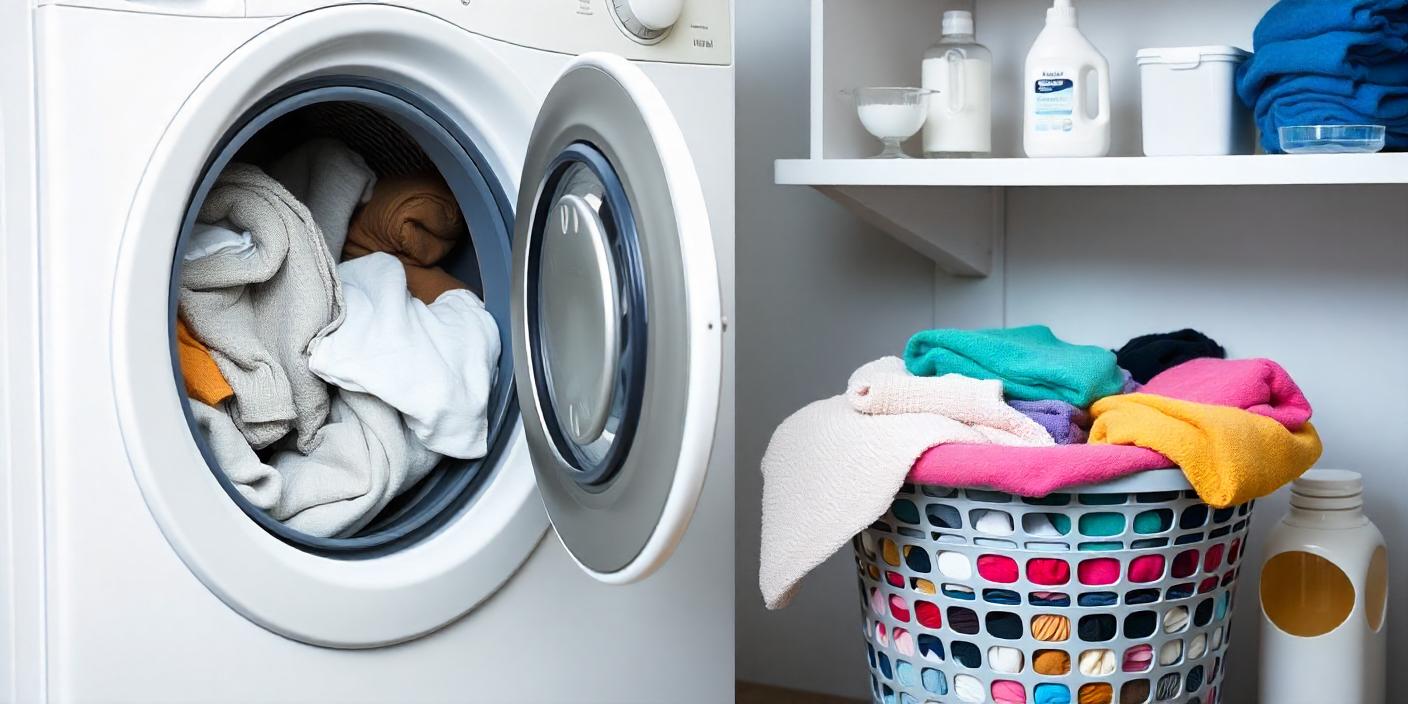02 Sep Common Laundry Mistakes: Mistakes People Make When Doing Laundry at Home
Laundry may seem straightforward, but doing it correctly is essential to keeping your clothes clean, fresh, and long-lasting. Many people unknowingly make common laundry mistakes that can damage their clothes over time. From using too much detergent to not sorting clothes properly, these errors can lead to discoloured, worn-out fabrics and even damage your washing machine. By learning how to do laundry correctly and avoiding these common pitfalls, you can protect your clothes and save time and money in the long run. This guide will help you identify and avoid laundry errors for better results every time you wash.
What Are the Common Laundry Mistakes?
1. Using Too Much Detergent
One of the most common laundry mistakes is assuming that more detergent equals cleaner clothes. In reality, using too much detergent can have the opposite effect. Instead of getting your clothes spotless, excess detergent can lead to residue build-up on fabrics, trapping dirt and odours in the fibres. Over time, this can damage your clothes, leaving them stiff and dull, and even affect the performance of your washing machine.
To do laundry correctly, it’s crucial to measure the detergent based on the size of your load and the type of water you’re using. Hard water requires a bit more detergent, while soft water needs less. Most washing machines and detergent bottles provide guidelines, so following them will help you avoid one of the biggest laundry errors and keep your clothes looking fresh without unnecessary wear and tear.
2. Not Sorting Clothes Properly
A frequent laundry mistake is tossing all your clothes into the washing machine without sorting them first. While this might seem like a time-saver, it often leads to many problems. One of the most common issues is colour bleeding, where dark or brightly coloured clothes transfer their dye to lighter fabrics. Additionally, different fabric types require different care, and washing delicate fabrics alongside heavy items like jeans can cause premature wear and tear.
To do laundry correctly, sorting your clothes before washing is essential. Begin by separating your laundry into groups based on colour (light, dark, and bright), fabric type (delicates, cotton, synthetics), and even dirtiness. This simple habit helps you avoid laundry errors that can damage your clothes and ensures each load is cleaned effectively while preserving the quality of your fabrics.
3. Ignoring Care Labels
One of the most overlooked laundry mistakes is ignoring the care labels on garments. These labels are there for a reason—they provide essential information on how to treat your clothes properly. Skipping this step can lead to easily avoidable mishaps, like washing delicate fabrics in hot water or using the wrong washing cycle, which can shrink, stretch, or damage your clothes.
To do laundry correctly, always take a moment to read the care labels before tossing anything into the washer. They give specific instructions for each fabric’s ideal temperature, washing cycle, and drying method. By following these guidelines, you can avoid laundry errors that could ruin your favourite outfits and ensure your clothes stay in good condition for much longer.
4. Overloading the Washing Machine
Overloading the washing machine is another common laundry mistake many people make to save time. While cramming as many clothes as possible into a single load might seem efficient, this often leads to poor cleaning results. Clothes need space in the washer for water and detergent to circulate correctly. When overloaded, they may come out still dirty or improperly rinsed. Plus, overloading can cause unnecessary wear on your machine, potentially leading to costly repairs.
To do laundry correctly, stick to your machine’s recommended load size. Most washers have guides for small, medium, and large loads. By following these guidelines, you’ll avoid laundry errors, thoroughly clean your clothes, and keep your machine in good working order.
5. Not Cleaning the Washing Machine
One of the most overlooked laundry mistakes is neglecting to clean the washing machine. Over time, detergent residue, fabric softener, and dirt from your clothes can build up inside the machine. A dirty washer can lead to unpleasant odours and even make your clothes come out less clean. Not maintaining the machine regularly can shorten its lifespan and reduce efficiency.
To do laundry correctly, it’s crucial to adopt a simple washing machine cleaning routine. Run an empty cycle with hot water and vinegar or a specialized washing machine cleaner every few weeks to remove buildup. Cleaning the detergent drawer and rubber seals is also essential. This regular upkeep will help you avoid laundry errors and ensure your machine works properly, leaving your clothes fresh and clean every time.
6. Using Incorrect Water Temperature
Choosing the wrong water temperature is a frequent laundry mistake that can significantly impact the condition and cleanliness of your clothes. Here’s how incorrect water temperature can affect your laundry:
- Hot Water: While hot water is effective for removing tough stains and sanitizing, it can also cause:
- Shrinking: Certain fabrics, like cotton, may shrink in hot water.
- Fading: Bright colours and patterns can bleed or fade.
- Damage: Delicate fabrics can become weakened or damaged.
- Cold Water: Though gentle and energy-efficient, cold water might lead to:
- Inadequate Cleaning: It may not entirely remove heavy stains or bacteria.
- Odour Issues: Sometimes, cold water might leave clothes smelling less fresh.
To do laundry correctly and avoid laundry errors, follow these guidelines for using water temperature:
- Hot Water: Use for white and heavily soiled items that need deep cleaning and sanitizing.
- Warm Water: Ideal for everyday fabrics like cottons and blended fabrics that need a balance between cleaning and care.
- Cold Water: Delicate fabrics, dark colours, and lightly soiled items should prevent shrinkage and preserve colour.
You can keep your clothes in excellent condition and thoroughly clean without unnecessary damage by selecting the appropriate water temperature based on the fabric type and cleaning needs.
7. Neglecting Stains Before Washing: One of the most Common Laundry Mistakes
One of the most common laundry mistakes is tossing stained clothes straight into the washer without addressing the stains first. This approach often fails to remove tough stains and can sometimes even set them, making them harder to get out. When you don’t pre-treat stains, the washing machine alone may not be sufficient to lift them, especially if they’re particularly stubborn or old.
Common mistakes include:
- Skipping Pre-Treatment: Do not use a stain remover or pre-treat the stain before washing.
- Using Incorrect Stain Removers: Applying products unsuited for the type of stain or fabric can be ineffective or cause additional damage.
To do laundry correctly and effectively avoid laundry errors, follow these tips for stain treatment before washing:
- Act Quickly: Address stains as soon as possible. The sooner you treat them, the easier they will be to remove.
- Choose the Right Stain Remover: Use a stain remover appropriate for the type of stain (e.g., grease, ink, wine) and fabric. Read product labels for the best results.
- Test First: Always test the stain remover on a small, inconspicuous area of the fabric to ensure it doesn’t cause damage or discolouration.
- Apply Correctly: Follow the instructions on the stain remover, apply it directly to the stain, and let it sit for the recommended time before washing.
- Use the Right Washing Temperature: To maximize stain removal, wash the garment at the appropriate temperature for the stain type and fabric.
By properly pre-treating stains, you can enhance the effectiveness of your laundry routine and keep your clothes looking their best.
8. Overusing Fabric Softeners
Another common laundry mistake is the overuse of fabric softeners. While they can make clothes feel softer and smell fresher, excessive use can harm your fabrics. Too much fabric softener can create a buildup on your clothes, reducing their absorbency and making towels less effective and athletic wear less breathable. This buildup can also lead to a residue that may damage the fabric over time.
Additionally, fabric softeners are not always necessary and can sometimes be skipped in favour of more natural alternatives. Over-reliance on them can contribute to laundry errors affecting your clothes and washing machine.
To do laundry correctly and avoid laundry errors, consider these solutions:
- Use Sparingly: Follow the recommended amount on the fabric softener label and avoid using it with every load, especially with items like towels and athletic wear.
- Try Alternatives:
- Vinegar: Add half a cup of white vinegar to the rinse cycle. It helps soften clothes naturally and removes detergent residue without leaving a scent.
- Dryer Balls: Use wool or rubber dryer balls in the dryer to reduce static and soften clothes without chemicals.
- Evaluate Necessity: Consider whether you need fabric softener for each type of load. For many items, such as high-performance fabrics, it’s better to skip it altogether.
By using fabric softeners judiciously and exploring alternative methods, you can keep your laundry routine effective and your clothes in excellent condition.
9. Improper Drying Techniques
Improper drying techniques are a common laundry mistake that can lead to various issues with your clothes. One frequent error is over-drying, which can cause shrinkage and fabric damage. High heat is particularly harsh on delicate fabrics, often leading to distortion and weakening of fibers.
Here’s how improper drying can affect your laundry:
- Shrinking: Over-drying or high heat can shrink clothes, especially those made of natural fibres like cotton and wool.
- Fabric Damage: High temperatures can weaken fabrics, cause them to lose shape, or lead to pilling and fading.
- Wrinkles: Leaving clothes in the dryer too long can cause excessive wrinkling, which makes them look less polished.
To do laundry correctly and avoid laundry errors, follow these drying tips:
- Air-Dry When Possible: Consider air-drying by hanging them up or laying them flat on a clean surface for delicate items. This helps preserve the fabric’s shape and elasticity.
- Use Low Heat: If you use a dryer, opt for low heat settings or delicate cycles for fabrics prone to damage. Check your dryer’s settings to ensure they match the type of fabric you’re drying.
- Remove Clothes Promptly: To minimize wrinkles, take clothes out of the dryer as soon as the cycle ends. Fold or hang them immediately to keep them looking neat.
10. Not Folding Clothes Immediately After Drying
One often overlooked mistake is leaving clothes in the dryer or laundry basket for too long after drying. Failing to fold or hang clothes promptly can lead to wrinkles and creases, which can be challenging to remove and may require additional ironing or steaming.
Here’s how not dealing with clothes immediately after drying can affect your laundry:
- Wrinkles and Creases: Clothes left in the dryer can develop deep wrinkles and creases that may not quickly come out with a simple tumble in the dryer.
- Crease Set: Over time, wrinkles can set into the fabric, making them more challenging to remove, even with ironing.
- Less Efficient Organization: Clothes left in a pile can become disorganized, leading to a cluttered space and longer sorting times.
To do laundry correctly and avoid laundry errors, follow these best practices for folding and organizing clothes:
- Remove Promptly: Remove clothes as soon as the dryer cycle ends or they are dry to prevent wrinkles from setting.
- Fold or Hang Immediately: Fold clothes neatly or hang them up immediately to maintain their shape and prevent creasing.
- Use Proper Techniques: When folding, smooth out wrinkles as you fold to avoid setting them in. When hanging, use appropriate hangers for different types of clothing to preserve their shape.
- Organize Efficiently: Store folded clothes in drawers or shelves in an organized manner to keep your wardrobe tidy and accessible.
11. Using the Wrong Detergent for Certain Fabrics
- Why certain detergents are formulated for specific materials (e.g., delicates, wool, or synthetic fabrics)
- Common mistake: using general detergent for all fabrics
- Solution: Choosing the right detergent for different fabrics and laundry need
11. Using the Wrong Detergent for Certain Fabrics
Using the wrong detergent is a shared laundry mistake that can lead to various fabric issues. Different types of detergents are formulated to meet the specific needs of various materials, such as delicates, wool, or synthetic fabrics. Using a general detergent for all fabrics might not provide the proper care or cleaning, leading to potential damage or ineffective cleaning.
Here’s why choosing the right detergent matters:
- Delicate Fabrics: Delicate materials like silk or lace require gentle detergents to avoid damage. General detergents can be too harsh and may cause weakening or fraying.
- Wool: Wool fabrics need special detergents that help maintain their natural oils and prevent shrinking or felting. Regular detergents can strip these oils and cause shrinkage.
- Synthetic Fabrics: Synthetic materials like polyester often need detergents that effectively break down oils and stains. Detergents not designed for these fabrics might not clean them thoroughly.
To do laundry correctly and avoid laundry errors, follow these solutions:
- Identify Fabric Types: Before choosing a detergent, identify the fabrics you are washing. Refer to care labels and fabric types to select the appropriate detergent.
- Choose Specialized Detergents:
- Delicate Detergents: Use lingerie, silk, and other fragile items to ensure gentle cleaning.
- Wool Detergents: Opt for products designed for wool to prevent damage and maintain the integrity of the fibres.
- High-Efficiency Detergents: For synthetic fabrics and high-efficiency washers, use formulated detergents for these specific needs.
The Last Word
In summary, by avoiding common laundry mistakes like using too much detergent, improper sorting, ignoring care labels, or overloading the washing machine, you can maintain the quality of your clothes and extend their lifespan. Simple adjustments like using the correct water temperature, pre-treating stains, and choosing the suitable detergent for each fabric can make a difference in your laundry routine.
As the saying goes, “An ounce of prevention is worth a pound of cure.” Taking extra care with your laundry can save you time and money in the long run while keeping your clothes fresh and clean.
Adopting better laundry habits and investing in high-quality laundry tools and products will not only give you cleaner clothes but also make them last longer, reducing wear and tear over time. Remember, a well-maintained wardrobe starts with how you care for your clothes.




Sorry, the comment form is closed at this time.